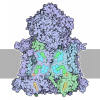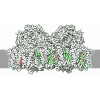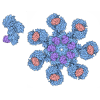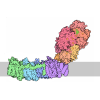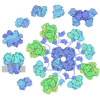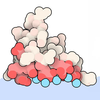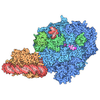+ Open data
Open data
- Basic information
Basic information
| Entry | Database: PDB / ID: 8zow | |||||||||||||||||||||
|---|---|---|---|---|---|---|---|---|---|---|---|---|---|---|---|---|---|---|---|---|---|---|
| Title | Cryo-EM structure of Metyltetraprole-bound porcine bc1 complex | |||||||||||||||||||||
 Components Components |
| |||||||||||||||||||||
 Keywords Keywords | PROTEIN BINDING / Metyltetraprole / Inhibitor / Complex | |||||||||||||||||||||
| Function / homology |  Function and homology information Function and homology informationComplex III assembly / subthalamus development / pons development / cerebellar Purkinje cell layer development / Respiratory electron transport / pyramidal neuron development / thalamus development / respiratory chain complex III / quinol-cytochrome-c reductase / quinol-cytochrome-c reductase activity ...Complex III assembly / subthalamus development / pons development / cerebellar Purkinje cell layer development / Respiratory electron transport / pyramidal neuron development / thalamus development / respiratory chain complex III / quinol-cytochrome-c reductase / quinol-cytochrome-c reductase activity / mitochondrial electron transport, ubiquinol to cytochrome c / hypothalamus development / midbrain development / hippocampus development / metalloendopeptidase activity / 2 iron, 2 sulfur cluster binding / electron transfer activity / mitochondrial inner membrane / heme binding / proteolysis / metal ion binding / membrane Similarity search - Function | |||||||||||||||||||||
| Biological species |  | |||||||||||||||||||||
| Method | ELECTRON MICROSCOPY / single particle reconstruction / cryo EM / Resolution: 2.53 Å | |||||||||||||||||||||
 Authors Authors | Wang, Y.X. / Sun, J.Y. / Cui, G.R. / Yang, G.F. | |||||||||||||||||||||
| Funding support |  China, 1items China, 1items
| |||||||||||||||||||||
 Citation Citation |  Journal: J Am Chem Soc / Year: 2024 Journal: J Am Chem Soc / Year: 2024Title: Cryo-EM Structures Reveal the Unique Binding Modes of Metyltetraprole in Yeast and Porcine Cytochrome Complex Enabling Rational Design of Inhibitors. Authors: Yu-Xia Wang / Ying Ye / Zhi-Wen Li / Guang-Rui Cui / Xing-Xing Shi / Ying Dong / Jia-Jia Jiang / Jia-Yue Sun / Ze-Wei Guan / Nan Zhang / Qiong-You Wu / Fan Wang / Xiao-Lei Zhu / Guang-Fu Yang /  Abstract: Cytochrome (complex III) represents a significant target for the discovery of both drugs and fungicides. Metyltetraprole (MET) is commonly classified as a quinone site inhibitor (QI) that combats ...Cytochrome (complex III) represents a significant target for the discovery of both drugs and fungicides. Metyltetraprole (MET) is commonly classified as a quinone site inhibitor (QI) that combats the G143A mutated isolate, which confers high resistance to strobilurin fungicides such as pyraclostrobin (PYR). The binding mode and antiresistance mechanism of MET remain unclear. Here, we determined the high-resolution structures of inhibitor-bound complex III (MET, 2.52 Å; PYR, 2.42 Å) and inhibitor-bound porcine complex III (MET, 2.53 Å; PYR, 2,37 Å) by cryo-electron microscopy. The distinct binding modes of MET and PYR were observed for the first time. Notably, the MET exhibited different binding modes in the two species. In , the binding site of MET was the same as PYR, serving as a -type inhibitor of the Q site. However, in porcine, MET acted as a dual-target inhibitor of both Q and Q. Based on the structural insights, a novel inhibitor (YF23694) was discovered and demonstrated excellent fungicidal activity against downy mildew and powdery mildew fungi. This work provides a new starting point for the design of the next generation of inhibitors to overcome the resistance. | |||||||||||||||||||||
| History |
|
- Structure visualization
Structure visualization
| Structure viewer | Molecule:  Molmil Molmil Jmol/JSmol Jmol/JSmol |
|---|
- Downloads & links
Downloads & links
- Download
Download
| PDBx/mmCIF format |  8zow.cif.gz 8zow.cif.gz | 750.7 KB | Display |  PDBx/mmCIF format PDBx/mmCIF format |
|---|---|---|---|---|
| PDB format |  pdb8zow.ent.gz pdb8zow.ent.gz | Display |  PDB format PDB format | |
| PDBx/mmJSON format |  8zow.json.gz 8zow.json.gz | Tree view |  PDBx/mmJSON format PDBx/mmJSON format | |
| Others |  Other downloads Other downloads |
-Validation report
| Summary document |  8zow_validation.pdf.gz 8zow_validation.pdf.gz | 1.3 MB | Display |  wwPDB validaton report wwPDB validaton report |
|---|---|---|---|---|
| Full document |  8zow_full_validation.pdf.gz 8zow_full_validation.pdf.gz | 1.4 MB | Display | |
| Data in XML |  8zow_validation.xml.gz 8zow_validation.xml.gz | 88.8 KB | Display | |
| Data in CIF |  8zow_validation.cif.gz 8zow_validation.cif.gz | 133.2 KB | Display | |
| Arichive directory |  https://data.pdbj.org/pub/pdb/validation_reports/zo/8zow https://data.pdbj.org/pub/pdb/validation_reports/zo/8zow ftp://data.pdbj.org/pub/pdb/validation_reports/zo/8zow ftp://data.pdbj.org/pub/pdb/validation_reports/zo/8zow | HTTPS FTP |
-Related structure data
| Related structure data |  60320MC  8yhqC  8yinC  8zmtC  8zosC  8zp0C M: map data used to model this data C: citing same article ( |
|---|---|
| Similar structure data | Similarity search - Function & homology  F&H Search F&H Search |
- Links
Links
- Assembly
Assembly
| Deposited unit | 
|
|---|---|
| 1 |
|
- Components
Components
-Protein , 3 types, 6 molecules AaBbIi
| #1: Protein | Mass: 42709.520 Da / Num. of mol.: 2 / Source method: isolated from a natural source / Source: (natural)  #2: Protein | Mass: 27373.357 Da / Num. of mol.: 2 / Source method: isolated from a natural source / Source: (natural)  #9: Protein | Mass: 7152.220 Da / Num. of mol.: 2 / Source method: isolated from a natural source / Source: (natural)  |
|---|
-Cytochrome b-c1 complex subunit ... , 8 types, 16 molecules CcDdEeFfGgHhJjKk
| #3: Protein | Mass: 21610.492 Da / Num. of mol.: 2 / Source method: isolated from a natural source / Source: (natural)  References: UniProt: A0A4X1TWD8, quinol-cytochrome-c reductase #4: Protein | Mass: 49270.133 Da / Num. of mol.: 2 / Source method: isolated from a natural source / Source: (natural)  #5: Protein | Mass: 44616.098 Da / Num. of mol.: 2 / Source method: isolated from a natural source / Source: (natural)  #6: Protein | Mass: 7592.541 Da / Num. of mol.: 2 / Source method: isolated from a natural source / Source: (natural)  #7: Protein | Mass: 13043.888 Da / Num. of mol.: 2 / Source method: isolated from a natural source / Source: (natural)  #8: Protein | Mass: 9408.876 Da / Num. of mol.: 2 / Source method: isolated from a natural source / Source: (natural)  #10: Protein | Mass: 6058.093 Da / Num. of mol.: 2 / Source method: isolated from a natural source / Source: (natural)  #11: Protein | Mass: 5790.676 Da / Num. of mol.: 2 / Source method: isolated from a natural source / Source: (natural)  References: UniProt: A0A480EHC1, quinol-cytochrome-c reductase |
|---|
-Non-polymers , 6 types, 16 molecules 








| #12: Chemical | ChemComp-A1D6P / Mass: 396.830 Da / Num. of mol.: 4 / Source method: obtained synthetically / Formula: C19H17ClN6O2 / Feature type: SUBJECT OF INVESTIGATION #13: Chemical | ChemComp-HEM / #14: Chemical | #15: Chemical | #16: Chemical | #17: Chemical | |
|---|
-Details
| Has ligand of interest | Y |
|---|---|
| Has protein modification | N |
-Experimental details
-Experiment
| Experiment | Method: ELECTRON MICROSCOPY |
|---|---|
| EM experiment | Aggregation state: PARTICLE / 3D reconstruction method: single particle reconstruction |
- Sample preparation
Sample preparation
| Component | Name: Cryo-EM structure of Metyltetraprole-bound porcine bc1 complex Type: COMPLEX / Entity ID: #1-#11 / Source: NATURAL |
|---|---|
| Source (natural) | Organism:  |
| Buffer solution | pH: 7.4 |
| Specimen | Embedding applied: NO / Shadowing applied: NO / Staining applied: NO / Vitrification applied: YES |
| Vitrification | Cryogen name: ETHANE |
- Electron microscopy imaging
Electron microscopy imaging
| Experimental equipment |  Model: Titan Krios / Image courtesy: FEI Company |
|---|---|
| Microscopy | Model: FEI TITAN KRIOS |
| Electron gun | Electron source:  FIELD EMISSION GUN / Accelerating voltage: 300 kV / Illumination mode: FLOOD BEAM FIELD EMISSION GUN / Accelerating voltage: 300 kV / Illumination mode: FLOOD BEAM |
| Electron lens | Mode: BRIGHT FIELD / Nominal defocus max: 1800 nm / Nominal defocus min: 1600 nm |
| Image recording | Electron dose: 49.72 e/Å2 / Film or detector model: FEI FALCON IV (4k x 4k) |
- Processing
Processing
| EM software | Name: PHENIX / Category: model refinement |
|---|---|
| CTF correction | Type: PHASE FLIPPING AND AMPLITUDE CORRECTION |
| 3D reconstruction | Resolution: 2.53 Å / Resolution method: FSC 0.143 CUT-OFF / Num. of particles: 411418 / Symmetry type: POINT |
 Movie
Movie Controller
Controller








 PDBj
PDBj